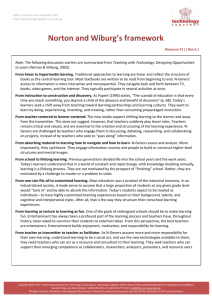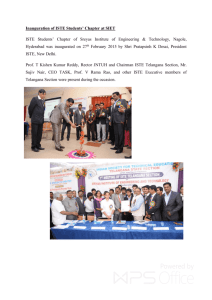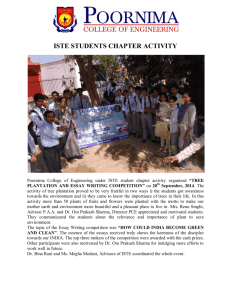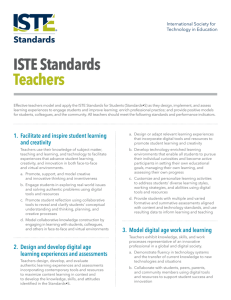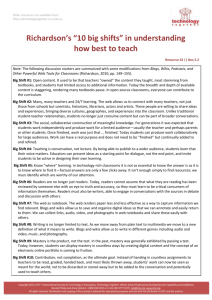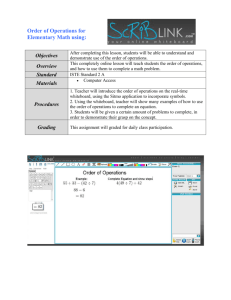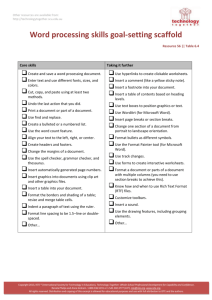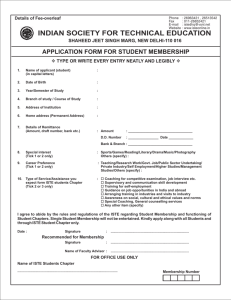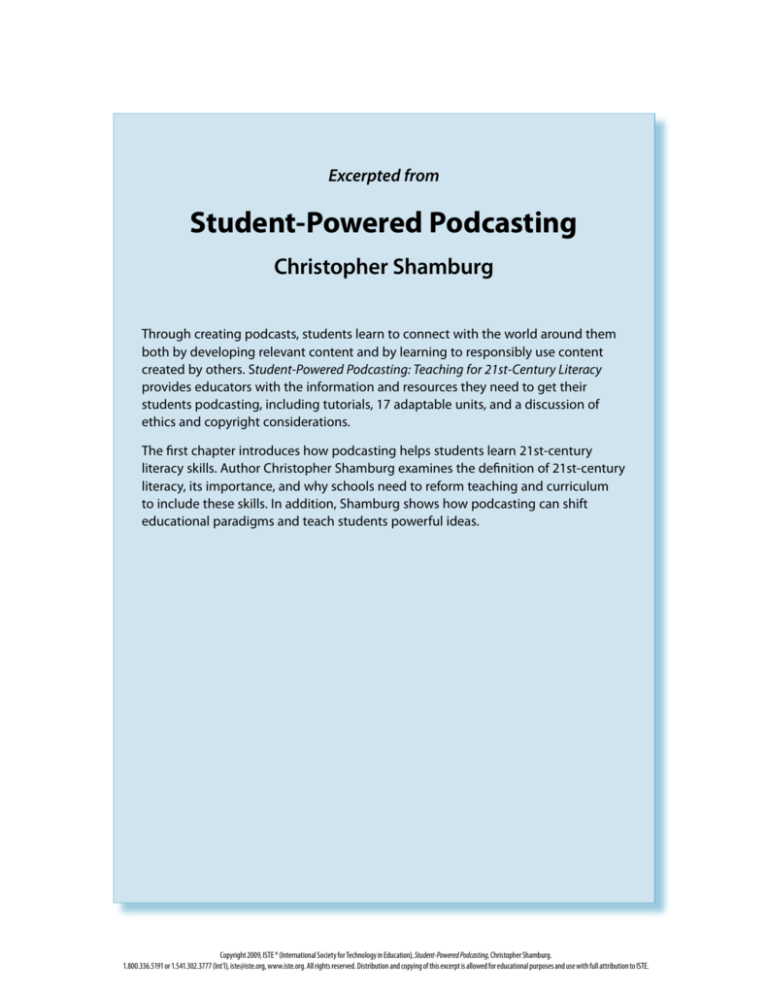
Excerpted from
Student-Powered Podcasting
Christopher Shamburg
Through creating podcasts, students learn to connect with the world around them
both by developing relevant content and by learning to responsibly use content
created by others. Student-Powered Podcasting: Teaching for 21st-Century Literacy
provides educators with the information and resources they need to get their
students podcasting, including tutorials, 17 adaptable units, and a discussion of
ethics and copyright considerations.
The first chapter introduces how podcasting helps students learn 21st-century
literacy skills. Author Christopher Shamburg examines the definition of 21st-century
literacy, its importance, and why schools need to reform teaching and curriculum
to include these skills. In addition, Shamburg shows how podcasting can shift
educational paradigms and teach students powerful ideas.
Copyright 2009, ISTE ® (International Society for Technology in Education), Student-Powered Podcasting, Christopher Shamburg.
1.800.336.5191 or 1.541.302.3777 (Int’l), iste@iste.org, www.iste.org. All rights reserved. Distribution and copying of this excerpt is allowed for educational purposes and use with full attribution to ISTE.
Chapter 1
Beyond Podcasting:
A Paradigm Shift
This chapter presents the big ideas of
student-powered podcasting: how it can connect to ideas
of 21st-century literacy, challenge existing educational
paradigms, and become a catalyst for teaching powerful
ideas.
Podcasting is the creation and serial distribution of
media through the Internet. Audio and video files (often
thought of as “episodes”) are created and disseminated
on a regular basis by a podcaster; a subscriber can easily
receive new episodes and episode information, and
download, view, listen, and transfer the episodes to a
variety of portable players. Technical information on how
to do these things is clearly presented in this book, but
the true subject of this book is what students can potentially learn using this technology.
Student-Powered Podcasting
5
Copyright 2009, ISTE ® (International Society for Technology in Education), Student-Powered Podcasting, Christopher Shamburg.
1.800.336.5191 or 1.541.302.3777 (Int’l), iste@iste.org, www.iste.org. All rights reserved. Distribution and copying of this excerpt is allowed for educational purposes and use with full attribution to ISTE.
Section I | Foundations
The specific technologies of podcasting offer an accessible and powerful tool
that can engage students and give them skills for success in the 21st century.
But the benefits of podcasting can go beyond technological proficiency and
academic content knowledge, beyond enhancing the existing curriculum, and
even beyond podcasting itself. Let me explain.
Podcasting offers an inexpensive way to create and share compelling media
that correlates to authentic activities outside of school. Students who podcast
become active participants in culture and society. They can create original
content as they ethically and effectively collect and remix the work of others.
Students can create audio dramas, news shows, or audio tours. This book gives
directions, assessments, insights, and examples for a variety of multidisciplinary projects.
The ideas in this book began in 2006 when I was working with the
NJeSchool, the largest online public high school in New Jersey. We were
thinking about courses that would work better online than in a classroom, as
well as broader questions about the types of projects, skills, and mindsets that
students needed and the types of activities that they would like to engage in.
After research, reflection, and some risk taking, we came up with a language
arts class based on student podcasting that has been running ever since.
Ultimately, however, we also came to realize that we had struck on a paradigm
shift in curriculum development and teaching that correlated to larger social
and technological trends and went well beyond the specific technologies of
podcasting.
One reason the ideas in this book are a shift is because, as opposed to working
from antecedents in education, the content was primarily developed from
authentic activities outside of schools. The units in this book do not approach
podcasting as an enhancement of the existing curriculum, but rather as a catalyst for reflection and curricular reform. Furthermore, though the technology
is critical to the student projects, the ideas here are not simply about technological proficiency. The technology is a seamless part of real-world activities
with educational value that connect to several disciplines.
6
Student-Powered Podcasting
Copyright 2009, ISTE ® (International Society for Technology in Education), Student-Powered Podcasting, Christopher Shamburg.
1.800.336.5191 or 1.541.302.3777 (Int’l), iste@iste.org, www.iste.org. All rights reserved. Distribution and copying of this excerpt is allowed for educational purposes and use with full attribution to ISTE.
Beyond Podcasting: A Paradigm Shift | Chapter 1
Reading, Writing, Literacy,
and 21st-Century Literacy
Although in this book I do address existing content standards and conventional literacies—reading, writing, speaking—my main premise is that
students need to be directed in new literacies as well as conventional literacies. These new literacies cannot be simply tagged onto existing curriculum,
models, and mindsets.
A shorthand way to describe literacy involves “reading and writing text,”
but the term literacy connotes a far more complex process. There have been
distinctions between everyday literacy and academic literacy, for example, and
an association of literacy with “discourses,” or ways of acting in the world
(Gee, 2004). In New Literacies, Lankshear and Knobel (2003) make an important distinction between the terms reading and literacy. They posit that the
term reading conveys an internal, psychological process, while the term literacy
conveys a social process—connected to other practices, communities, economies, and empowerment.
There has been a shift in education over the past 30 years to focus on literacy
as opposed to reading—the changes are reflected in approaches, practices,
funding, and program names. Two of the major factors that contributed to
this shift from reading to literacy were, first, an awareness of the correlation
between illiteracy and unemployment in the United States during the 1970s
and, second, the growing trends in psychology and other social sciences to see
learning as a larger social process as opposed to an isolated cognitive process
(Lankshear & Knobel, 2003). This book looks at literacy both as the skills of
reading and writing text and as the broader, complex social processes.
Moreover, it’s the extension and clarification of these broader social processes
that is the launching point of 21st-century literacy, the main focus of this
book. It would be easy to dismiss the term 21st-century literacy as just another
adaptation of the word literacy—at best, a term capturing a specific educational
agenda, and at worst more jargon in the data smog. For me, the fundamental
question “Why do we teach children to read?” helps clarify the importance of
emphasizing what’s unique about 21st-century literacy. We teach reading to
enable participation and empowerment—we want students to succeed in the
world, so it’s important that they be able to understand others and communicate their own ideas.
Student-Powered Podcasting
7
Copyright 2009, ISTE ® (International Society for Technology in Education), Student-Powered Podcasting, Christopher Shamburg.
1.800.336.5191 or 1.541.302.3777 (Int’l), iste@iste.org, www.iste.org. All rights reserved. Distribution and copying of this excerpt is allowed for educational purposes and use with full attribution to ISTE.
Section I | Foundations
Even a skeptic would likely acknowledge that for these goals to be realized
in the 21st century, new skills and mindsets are required. Although specific
technologies such as Second Life, microblogging, iPods, and podcasting could
be included in the catalog of 21st-century literacy tools, the term 21st-century
literacy captures a skill set and frame of mind bigger and less ephemeral than
proficiency with the latest technologies.
I believe that we are at a revolutionary point in our history, a paradigm shift
akin to the introduction of writing to the ancient Greeks or the effects of the
printing press on Early Modern Europeans. We need to look at our teaching
in this larger sweep of history. Twenty-first-century literacies involve the skills
and mindsets associated with the digital technologies and global networking
of the information age. These skills and mindsets are related to the immediate
technologies, but they are also related to the larger and tacit shifts associated
with digital technologies and global networking—shifts in social structures,
culture, capital, and labor.
There are some fascinating examinations of 21st-century literacy that informed
the direction of my work with student podcasting and the ideas of this book.
Prominent among them were Lankshear and Knobel’s New Literacies (2003),
William Kist’s New Literacies in Action (2004), and Henry Jenkins’ Convergence Culture (2006b), Confronting the Challenges of Participatory Culture: Media
Education in the 21st Century (2006a), and the American Association of School
Librarians’ Standards for the 21st-Century Learner (2007). Below are common
key ideas that informed the direction of this work.
Participation. Digital technologies have given us unprecedented abilities
to create media and content to express ourselves to various and wide
audiences. Media creation tools and distribution networks that 20 years
ago were available only to a handful of media conglomerates now come
preloaded on even the least expensive computers. Almost anyone can
create and distribute media and actively participate in culture, politics,
and communities. Students need to identify appropriate venues for diverse
media and content. They need the skills to compellingly create content for
real purposes and real audiences. Our students need to be active creators,
not passive consumers. They need to be engaged citizens and self-directed
workers.
Appropriation. Remixes, embedding media, and copying and pasting are
part of the constitution of our digital environment. Students need the
skills and mindsets to effectively and ethically synthesize the work of
8
Student-Powered Podcasting
Copyright 2009, ISTE ® (International Society for Technology in Education), Student-Powered Podcasting, Christopher Shamburg.
1.800.336.5191 or 1.541.302.3777 (Int’l), iste@iste.org, www.iste.org. All rights reserved. Distribution and copying of this excerpt is allowed for educational purposes and use with full attribution to ISTE.
Beyond Podcasting: A Paradigm Shift | Chapter 1
others into original and compelling work. These skills are the foundation
of audio remixes as well as good research papers.
Mediums. Students need to know that different mediums (audio, video,
text) and different technologies (podcasting, online video, blogging) have
different properties, purposes, advantages, and weaknesses. They need to
learn how to identify, choose, innovate, and capitalize on these mediums
and technologies.
Ethical Behavior. Students need to understand that with the opportunities
possible with networked and digital technologies, there are also risks
and responsibilities. We cannot teach this to students by blocking out the
changing world, but must instead develop techniques to guide them in
developing their own ethical compasses and responsible behaviors. They
need to be able to identify ethical boundaries and existing abuses of new
media.
Personal Interests. In traditional schools, students are often required to
repress their individual interests and learn the curriculum of the school.
Schools need to take a more dialectic approach between the goals of
the school and the experiences and goals of the students. This not only
correlates with much of the past three decades of research on cognitive
science, but also matches the skills needed for today’s world. As already
mentioned, today’s social and economic systems require more individual
volition and portable skill sets. The ability to identify, hone, and connect
personal interests to communities and organizations that value those skills
is the path to a fulfilling life.
These are some of the premium skills for engagement and success in the 21st
century, and podcasting is a powerful and accessible activity for teaching
them.
Tensions and Conflicts
The skills and mindsets associated with new literacies are challenging many
traditional paradigms of our culture. I believe they’re also causing a need for a
conceptual shift in our approach to education. It’s worth highlighting some of
the subtle but powerful paradigms that have outlived their usefulness in our
digital and global world.
Student-Powered Podcasting
9
Copyright 2009, ISTE ® (International Society for Technology in Education), Student-Powered Podcasting, Christopher Shamburg.
1.800.336.5191 or 1.541.302.3777 (Int’l), iste@iste.org, www.iste.org. All rights reserved. Distribution and copying of this excerpt is allowed for educational purposes and use with full attribution to ISTE.
Section I | Foundations
An increasingly blurry separation in society is the one between consumers and
creators of media. Most of our systems—schools, law, entertainment—have
been built on a strict separation between consumers and creators of content.
Some of these systems—the United States legal system, for example—have
built hundreds of years of precedents on this dichotomy. The recent explosion
of digital technology that enables people to copy, share, and remix is a precipitous challenge to the workings of these systems. It’s now more important than
ever to educate students on the ethics and legalities associated with copyright,
fair use, and the ethical appropriation of others’ content.
In education, we generally strongly distinguish between individual and
collaborative endeavors. But this dichotomy between independence and
collaboration is not as simple outside of schools as we make it within schools.
Our networked digital world facilitates and often even requires interdependence in both work and social life. I find that, using technology, many of my
students spend their free time collaborating with, and receiving instantaneous
feedback from, their peers—and they’re tremendously engaged by it. The
activities in this book attempt to harness that engagement.
In literacy and humanities education I see an unnecessary split between
material that students are interested in and more traditional literature and
curricular content. I would argue that students’ perceived lack of interest in
history, Shakespeare, poetry, or Jane Austen novels has nothing to do with
history, Shakespeare, poets, or Austen, but with a teaching tradition that relies
on rote memorization of facts, formalist essay topics, and the mechanics of
literary analysis. If teachers would instead deeply reflect on what brings people
to this material, students would more easily develop a natural affection for it.
I hope the projects in this book will offer you new ways of approaching the
material you teach that will truly spark your students’ interest.
Cultivating Powerful Ideas
The units in this book are based on the space where real-world activities
connect to student interests and powerful ideas. For this book, I define “realworld activities” as activities that occur outside of school and that are done in
communities by professionals. Podcasting tours, news stories, audio dramas,
and media reviews are examples of real-world activities. These activities come
with their own goals, communities, examples, and models. The objective
10
Student-Powered Podcasting
Copyright 2009, ISTE ® (International Society for Technology in Education), Student-Powered Podcasting, Christopher Shamburg.
1.800.336.5191 or 1.541.302.3777 (Int’l), iste@iste.org, www.iste.org. All rights reserved. Distribution and copying of this excerpt is allowed for educational purposes and use with full attribution to ISTE.
Beyond Podcasting: A Paradigm Shift | Chapter 1
of the podcasting course was to find and refine activities that maximized
student interest and choice. For example, in the audio tours lesson, not only
do students choose a place of interest, but they focus on making the tours
engaging and interesting to audiences of their choice.
Applying the term “powerful ideas” to educational technology was pioneered
by Seymour Papert in his groundbreaking book Mindstorms: Children,
Computers, and Powerful Ideas (1980). Papert saw technology as a catalyst for
powerful ideas. He writes that “one comes to appreciate how certain ideas can
be used as tools to think with over a lifetime. One learns to enjoy and respect
the power of powerful ideas” (p. 76). I want to convince you that podcasting
can be a vehicle for teaching powerful ideas—not simply a new way to teach
existing curriculum. My observations encourage me to think that studentpowered podcasting can promote several powerful ideas—ideas that students
can use over a lifetime. For example, the hands-on and reflective approach to
copyright, fair use, and digital media that students employ in their podcasting
can become a tool for them to think about the balance of individual rights
and community benefits. Similarly, the powerful idea of audience, whether
in creating a media review or an audio tour, can become a tool for them
to empathize with and anticipate the needs of others. In student-powered
podcasting, these issues are not isolated lessons, but fundamentals of students’
work as podcasters.
New technologies do not necessarily lead to better teaching. I feel frustration when I see a tech-savvy and well-intentioned teacher, standing at the
front of a class, cranking up a set of desktop speakers and playing a podcast
that “enhances” the existing curriculum. Regardless of how compelling and
polished the content is, if that’s the extent of the technology integration, the
teacher is most likely simply reinforcing passivity in the learners. On the other
hand, I feel excitement when I see students empowered with creative technology tools that help them effectively participate in media creation, personal
understanding, and communication with others.
Teach your students to podcast, and you’ll take them further down the road to
21st-century literacy.
Student-Powered Podcasting
11
Copyright 2009, ISTE ® (International Society for Technology in Education), Student-Powered Podcasting, Christopher Shamburg.
1.800.336.5191 or 1.541.302.3777 (Int’l), iste@iste.org, www.iste.org. All rights reserved. Distribution and copying of this excerpt is allowed for educational purposes and use with full attribution to ISTE.
Section I | Foundations
Works Cited
American Association of School Librarians (2007). Standards for the
21st-century learner. Retrieved November 12, 2008, from
www.ala.org/ala/mgrps/divs/aasl/aaslproftools/learningstandards/
AASL_LearningStandards.pdf
Gee, J. P. (2004). Situated language and learning: A critique of traditional schooling.
New York: Routledge.
Jenkins, H. (2006a). Confronting the challenges of participatory culture:
Media education for the 21st century. Boston: MacArthur Foundation.
Retrieved July 7, 2008, from
http://newmedialiteracies.org/files/working/NMLWhitePaper.pdf
Jenkins, H. (2006b). Convergence culture: Where old and new media collide.
New York: New York University Press.
Kist, W. (2004). New literacies in action: Teaching and learning in multiple media
(Language and Literacy Series). New York: Teachers College Press.
Lankshear, C., & Knobel, M. (2006). New literacies (2nd ed., p. 272).
Open University Press.
Papert, S. (1980). Mindstorms: Children, computers, and powerful ideas.
New York: Basic Books.
12
Student-Powered Podcasting
Copyright 2009, ISTE ® (International Society for Technology in Education), Student-Powered Podcasting, Christopher Shamburg.
1.800.336.5191 or 1.541.302.3777 (Int’l), iste@iste.org, www.iste.org. All rights reserved. Distribution and copying of this excerpt is allowed for educational purposes and use with full attribution to ISTE.
Christopher Shamburg is an associate professor in the graduate
program in educational technology at New Jersey City University.
Before teaching college, he was a high school English teacher at
the Hudson County School of Technology in Jersey City for 10 years
and won several awards, including Teacher of the Year, a Geraldine
R. Dodge Award for Teaching Humanities, a Governor’s Award
for Outstanding Teaching, and two fellowships from the National
Endowment for the Humanities. He has published and presented
numerous articles and papers on educational technology and is the
author of English Language Arts Units for Grades 9–12 (ISTE, 2008).
October 2009
202 pp. 7 x 9¼
Product code: PODHUM
978-1-56484-261-9
Order now by phone, by fax, or online. Single copy price is $32.95.
ISTE member price is $23.05. Special bulk pricing is available. Call
1.800.336.5191 or go to www.iste.org/podhum.
Copyright 2009, ISTE ® (International Society for Technology in Education), Student-Powered Podcasting, Christopher Shamburg.
1.800.336.5191 or 1.541.302.3777 (Int’l), iste@iste.org, www.iste.org. All rights reserved. Distribution and copying of this excerpt is allowed for educational purposes and use with full attribution to ISTE.

